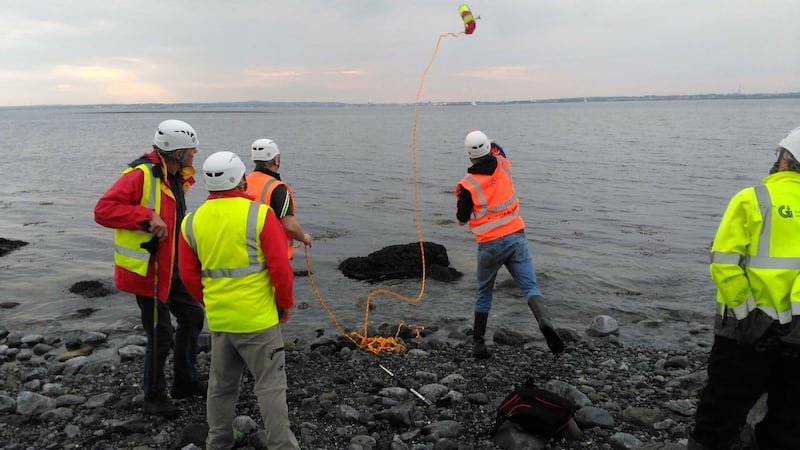When mobile phones rang looking for help in south Galway's Oranmore just over two years ago, Mike Cummins was one of many who said "yes". An NUI Galway student was missing and his family was distraught.
Few living in or visiting Galway over that Christmas will forget the response. From Kinvara in the south right around to An Spidéal, hundreds turned out to comb the coastal rim, scanning rock and shore for any sign of the young man.
"It was unprecedented," teacher Joe Kennelly recalls. " Initially, the search had been focused in and around the Claddagh, after the student was reported missing on December 17th. From St Stephen's Day, it had moved from Mill Street Garda station in the city across the bay to Oranmore, and the numbers that came out exceeded all expectations."

Kennelly is a regular sea swimmer, but many were not so familiar with tides and shore topography. Safety became an early concern for the gardaí, with weather conditions proving particularly challenging. Oranmore’s secondary school, Calasanctius College, was offered as a temporary base, and soup and sandwiches began appearing from all directions.
“Each day a new and more professional concept unfolded,” Kennelly says. “The search area was divided into zones, maps were photocopied, laminated and displayed throughout the hall. Zone leaders were nominated. Search procedures were put in place.”
Pastoral care was offered to family and friends of the missing student. A mobile phone text group transmitted rotas. The energy, goodwill and enthusiasm was “palpable”, Kennelly says.
In mid- January, the young man’s body was found close to Rinville point. It was heartbreaking, but a relief to his parents and family members, who had drawn so much support from those around them.
That next winter, there would be four more searches over a 10-week period. Cummins and Kennelly and others got talking, and a meeting in Oranmore library led to the establishment of the Oranmore Maree Coastal Search Unit which has the numbers and names of 370 volunteers on a text alert system. The Garda, Civil Defence, RNLI Galway inshore lifeboat, and Galway Fire Brigade, along with harbourmaster Capt Brian Sheridan, have offered their support.

"Galway is unique, in that the river Corrib is the fastest flowing river of its type in Europe and nine out of 10 casualties are swept into the bay," Cummins, chair of the unit, explains.
“Galway Fire Brigade has a highly trained river rescue team, which has recovered people alive from the river,” Kennelly adds.
"However, we know when we get a call that it is about recovery, rather than rescue," Cummins says. "We now have access to a Marine Institute system which combines tide and current to provide a type of forecasting system. That way, we can have a fairly targeted search effort."
There have been seven major searches to date, the longest lasting 42 days. Each zone leader carries a bag with binoculars, rope, hypothermic blanket, maps, first aid kit and whistle. The unit has been offered the use of a rigid inflatable boat (RIB), for use in more inaccessible areas like Rabbit Island, and Ciarán Oliver of Galway RNLI and Sea Scouts has provided training for a crew of eight, including three helms.
“The RIB came from a local businessman, and businesses have been absolutely amazing, “Cummins says. “Each time there is a search, there are unsolicited offers of food and supplies, and the community forms the kitchen. We now have a hospitality trailer which we use to set up hot food in other search locations”.
The unit has access to a network of bases, extending from Calasanctius school to community centres in Maree and Oranmore, Galway Bay Sailing Club at Rinville, and the city's Liam Mellows GAA club. Volunteers have travelled as far as Ros-a-Mhil on the northside of the bay. A logo with a heron and Oranmore castle has been designed, insurance has been taken out, and the unit has registered as a limited company with charity status.
Among the many regular volunteers are members of bereaved families who are well familiar with the unit’s work, and who travel frequently from Clare, Mayo, Westmeath and further to assist with searches.
"I don't know how these people find the strength to do it, but they do,"Cummins says, recalling how Bernard Lucas, widower of Irish Coast Guard Doolin volunteer Caitriona Lucas, was among the first to travel to north Mayo in March 2017 to search for the missing Irish Coast Guard Rescue 116 helicopter crew.
“The strength that people find in these situations is something none of us can quite comprehend,” Kennelly says. “There are days when you would be out, and you would find yourself walking alongside a father or sister of someone who was recovered from the bay, and the words they find are just so inspiring. That’s what keeps us doing what we do . . .”












